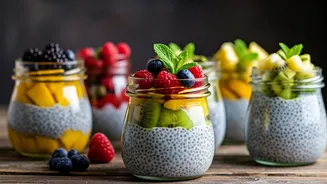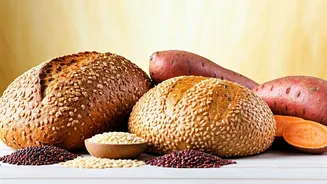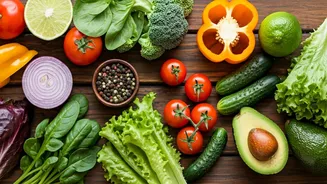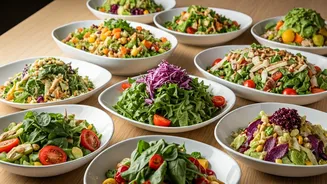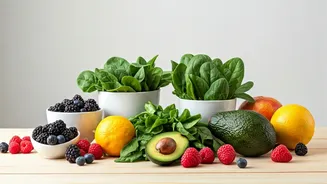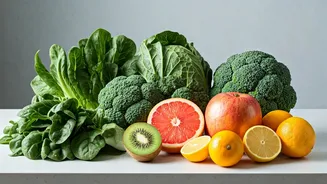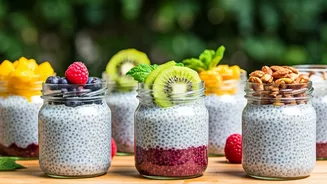Exploring Nutrition Trends
Staying abreast of nutritional trends can be challenging but essential for making informed decisions about food choices. The MyFitnessPal blog often highlights
emerging trends, which are areas of interest within the broader nutrition landscape. This can include discussions around plant-based diets, the rising popularity of specific superfoods, or new approaches to meal prepping. Understanding these trends can help you tailor your eating habits to support your health goals. Consider how you can incorporate these trends into your own routine. Trends can vary widely, from specific diets gaining popularity to highlighting a particular ingredient. Evaluate the trend critically, considering its scientific backing and how it fits within your lifestyle and dietary needs. Some trends are fleeting, while others may offer lasting benefits. For example, the focus on mindful eating, where you are encouraged to pay more attention to your hunger cues, is a solid strategy that transcends specific food fashions. Similarly, understanding the advantages of minimally processed foods, such as whole grains, fresh produce, and lean proteins, remains relevant. When assessing a nutrition trend, evaluate the source of the information. Look for evidence-based advice and recommendations that are supported by research and credible experts, such as registered dietitians or nutritionists. Be wary of quick fixes or promises that seem too good to be true. Remember that healthy eating is about making consistent and sustainable choices. The MyFitnessPal blog usually emphasizes the importance of a balanced approach that fits your individual requirements and preferences.
Meal Planning Essentials
Effective meal planning is a cornerstone of a healthy lifestyle, and the MyFitnessPal blog often shares practical advice on how to get started. The first step involves creating a plan tailored to your needs. Start by assessing your current eating habits and identify areas that need improvement. Determine the number of meals and snacks you need per day and consider your schedule. Take into account your lifestyle, and factor in things like work commitments, social events, and your time. Next, plan your meals for the week, including breakfast, lunch, dinner, and any snacks. Use the MyFitnessPal app to look up recipes that fit your dietary needs and preferences. Use it to keep track of the nutrition facts and calorie counts for everything you eat. When you plan your meals, start by choosing a theme for each day. This can help prevent decision fatigue and ensure you have variety in your diet. Themes might be “Meatless Mondays”, or “Taco Tuesdays.” Consider incorporating seasonal ingredients that are readily available and affordable. Create a shopping list based on your meal plan to ensure you have all the necessary ingredients on hand. Plan for the week so you avoid impulsive eating. Meal prepping can significantly streamline your meal planning efforts. Dedicate some time each week to prepare meals and snacks in advance. Chop vegetables, cook grains, and portion out meals into containers for easy grab-and-go convenience. Meal prepping saves you time during the busy week, helping you stay on track. Focus on recipes that are easy to prep, versatile, and taste great when reheated. By integrating these strategies, you are establishing a sustainable and effective approach to meal planning.
Delicious Recipe Ideas
The MyFitnessPal blog is a rich source of recipe ideas. One area usually explored is how to create nutritious and delicious meals that are easy to prepare. These recipes often focus on balanced ingredients that support overall health and weight management. A common theme is recipes that incorporate lean proteins, like chicken, fish, or tofu, along with plenty of fresh vegetables and whole grains. For example, a recipe might feature grilled chicken breast with roasted vegetables and quinoa. Another example is a simple yet satisfying meal with a salmon fillet, steamed broccoli, and brown rice. Vegetarian and vegan recipes are increasingly featured, accommodating diverse dietary preferences. These recipes frequently utilize plant-based proteins such as lentils, chickpeas, and beans, in addition to vegetables, fruits, nuts, and seeds. A lentil soup with a side of whole-wheat bread can offer a balanced meal. Explore variations with ingredients like chickpeas, spinach, and coconut milk for a flavorful, plant-based dinner option. When selecting recipes, focus on dishes with easily accessible ingredients, and that fit within your budget. Consider recipes that involve minimal cooking time or can be prepared in a single pan to reduce cleanup. The blog typically suggests looking for recipes that feature fresh produce, as it can boost your nutrient intake. The recipes often show how to incorporate fresh herbs and spices to add flavor without excess calories, sodium, or saturated fat. Make use of the MyFitnessPal app to find recipes, and track your meals. Experimenting with different cuisines can keep your meals exciting. Don't be afraid to try new ingredients or cooking methods to expand your culinary horizons.
Leveraging App Tools
The MyFitnessPal app is a vital tool for achieving your nutrition goals, and the blog often highlights features to maximize its effectiveness. One fundamental use is food logging. The app lets you log every meal and snack, tracking your calorie intake and macronutrient ratios (proteins, carbs, and fats). This enables you to understand your current eating habits and identify areas for improvement. You can search for foods in the database or scan barcodes. Regular logging helps keep track of your goals. Additionally, the app offers a comprehensive database with nutritional information for millions of food items. This database is regularly updated, and it is a reliable tool for accurately tracking your calorie intake. Another valuable feature is the ability to set personalized goals. You can specify weight loss, weight gain, or maintenance. The app then provides tailored recommendations for calorie targets and macronutrient breakdowns. You can customize the app to match your lifestyle and dietary needs. The MyFitnessPal app can also connect with other health and fitness apps, such as those that track physical activity, to give you a holistic view of your progress. Using these tools to their full potential is essential for success. Stay committed to logging your food and regularly reviewing your stats to make necessary adjustments. The app also helps you learn about portion sizes. The MyFitnessPal app gives users a clearer understanding of how to make choices that support long-term health.



